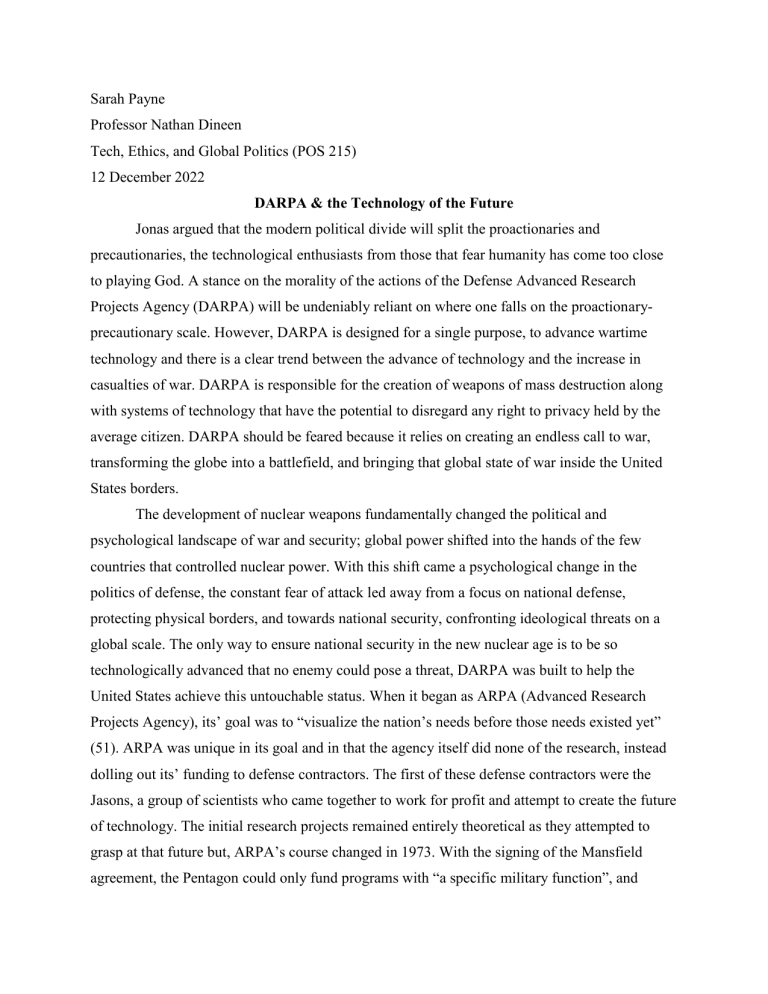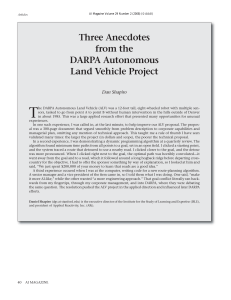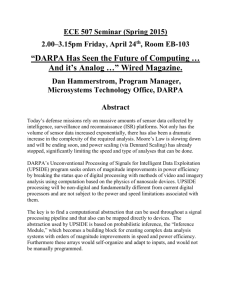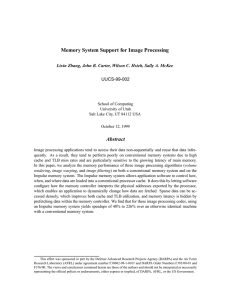
Sarah Payne Professor Nathan Dineen Tech, Ethics, and Global Politics (POS 215) 12 December 2022 DARPA & the Technology of the Future Jonas argued that the modern political divide will split the proactionaries and precautionaries, the technological enthusiasts from those that fear humanity has come too close to playing God. A stance on the morality of the actions of the Defense Advanced Research Projects Agency (DARPA) will be undeniably reliant on where one falls on the proactionaryprecautionary scale. However, DARPA is designed for a single purpose, to advance wartime technology and there is a clear trend between the advance of technology and the increase in casualties of war. DARPA is responsible for the creation of weapons of mass destruction along with systems of technology that have the potential to disregard any right to privacy held by the average citizen. DARPA should be feared because it relies on creating an endless call to war, transforming the globe into a battlefield, and bringing that global state of war inside the United States borders. The development of nuclear weapons fundamentally changed the political and psychological landscape of war and security; global power shifted into the hands of the few countries that controlled nuclear power. With this shift came a psychological change in the politics of defense, the constant fear of attack led away from a focus on national defense, protecting physical borders, and towards national security, confronting ideological threats on a global scale. The only way to ensure national security in the new nuclear age is to be so technologically advanced that no enemy could pose a threat, DARPA was built to help the United States achieve this untouchable status. When it began as ARPA (Advanced Research Projects Agency), its’ goal was to “visualize the nation’s needs before those needs existed yet” (51). ARPA was unique in its goal and in that the agency itself did none of the research, instead dolling out its’ funding to defense contractors. The first of these defense contractors were the Jasons, a group of scientists who came together to work for profit and attempt to create the future of technology. The initial research projects remained entirely theoretical as they attempted to grasp at that future but, ARPA’s course changed in 1973. With the signing of the Mansfield agreement, the Pentagon could only fund programs with “a specific military function”, and ARPA became DARPA (238). While DARPA’s purpose remained the same, it was now solely focused on developing military technology. It became in DARPAs best interest to discover new threats to national security, or in other words, stimulate an endless call to war. And, in 2001, the beginning of the war on terror became the greatest threat to national security, and the most complex problem handed to DARPA to be solved. Terror became the ideological threat that needed to be eradicated to ensure national security and because terror has no nation, the United States military had the self-given right to go anywhere in the name of protecting national security. As the military reached its influence into places where it never had before, DARPA was responsible for creating the technology that allowed battle to be waged anywhere. The idea that DARPA is turning the globe into a war zone is intrinsically tied with Porter’s ideas on physical distance in defense and the idea that technology and globalization have the potential create a world so interconnected that distance is negligible. This theoretical reality is the end goal for DARPA, each physical place where war cannot yet be waged is nothing more than a problem to be solved. In his discussion of globalization, Porter defines offensive realism as the idea that a nation can only really be safe if it has defeated all its’ enemies. The United States actions during the war on terror are a manifestation of offensive realism and DARPA is behind the massive amounts of technology that were developed in support of this goal. In the same way that DARPA stands to gain from fueling war, it stands to gain from turning the globe into a battlefield. The final ethical downfall of transforming every possible space into a battlefield is when it inevitably pushes the hand of war inside your own borders. In the 1960s the rise in peace protests against the Vietnam War by American citizens came to be viewed as a threat to national security. ARPA was tasked with developing, “a ‘non lethal’ weapons program to research and develop ways to stop demonstrators through painful but not deadly force” (219). The United States defense budget was being used to fund research into the development of weapons intended to be used against American citizens to keep them from speaking out against the government. Years later, DARPA technology was once again being used against American citizens. In 2013, the Snowden papers revealed that programs using technology developed to surveil enemies overseas had been transplanted into the United States and were being used to constantly monitor the actions of American citizens (399-401). DARPAs technology has been used to suppress the rights of Americans for decades. No one can deny that DARPA research has created some of the most influential technologies of our time. But as it continues to push the limits of human capability, one must answer the question, should it ever stop? Society has historically feared the unchecked advancement of technology for good reason. DARPA has done more than shape the future of technology, it has ensured that the most advanced research will always be done in the field of war and humanity's greatest technological achievements will never amount to more than a record-breaking casualty count.



